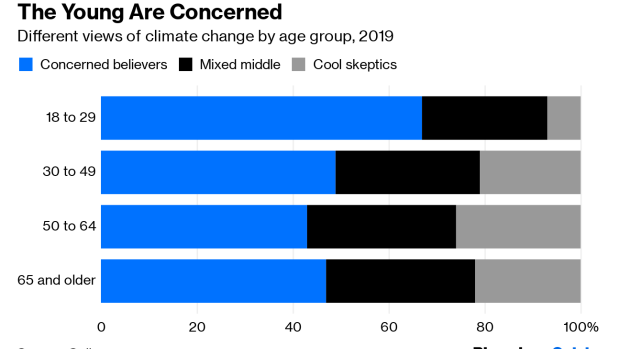Jun 14, 2019
Climate Change Is All Most of Us Have Ever Known
, Bloomberg News

(Bloomberg Opinion) -- In May, the Toronto Star launched an in-depth series on climate change in Canada, with a straightforward title: “Undeniable.” It’s an apt description of the evidence within the reporting and elsewhere in publicly available data.
“Undeniable” might be a useful descriptor, but let’s frame climate change differently: how this reality manifests itself within the human experience, and how politics are being shaped by that experience. Let’s begin with global average temperatures.
Global surface temperatures have surpassed the 1951-1980 average every year since 1977, which means anyone born since has lived their entire lives in an already changed climate.
In 2015, the global median age was just below 30, so a changing climate is the only thing most people on Earth have known.
Different age groups have contrasting views of a climate of constant change and volatility. A recent Gallup poll separated Americans into three climate change cohorts:
- "Concerned believers" are highly worried about global warming, think it will pose a serious threat in their lifetime, believe it's the result of human activity, and think news reports about it are accurate or underestimate the problem.
- "Cool skeptics" hold the opposite views on the same four questions: They worry little or not at all about global warming, do not think it will pose a serious threat in their lifetime, think it's attributable to natural environmental changes, and think the news exaggerates the problem.
- Those in the "mixed middle" hold a combination of views. For instance, some believe global warming is caused by humans but aren't worried about it, while others express the reverse perspective — saying warming is a natural phenomenon, but they are highly worried about it.
Those cohorts generally map to age: The younger the person, the more likely it is that they are a concerned believer.
But extreme weather is moving public opinion on climate change, too. University of Illinois professor Scott Irwin showed just how dire this year’s intersection of extremely wet weather and the Corn Belt’s planting season is. By the 22nd week of the year in three previous years of extremely late corn planting, at least 80 percent of the crop was already in the ground. This year, the corn crop was only only 67 percent planted.
That slowing planting progress comes as the U.S. just endured its wettest 12 months since 1895. There’s a trend in this pattern, too, similar to that in global surface temperature: above the 20th-century average not for years, but for decades.
According to the National Weather Service, the Mississippi River’s June 9 crest in St. Louis was the second-highest, behind the 1993 record, and six of the river’s 12 major crests on record have occurred since 2013. For someone living in the area, those river crests probably don’t feel like outliers; they might begin to register as the new normal. The Economist, reporting from flooded Illinois, says “floods and storms are altering American attitudes to climate change.”
This changing attitude can also be seen in the field of Democratic presidential candidates. Elizabeth Warren, who “has a plan for that,” has “My Green Manufacturing Plan for America.” Joe Biden has “Joe’s Plan for a Clean Energy Revolution and Environmental Justice.” Washington state Governor Jay Inslee has not only America’s Climate Mission, but also a plan for Global Climate Mobilization. In the same way that a changing climate is the reality for most people, it is becoming a political reality.
A constantly changing climate is all that most people on Earth know. Perhaps it’s not a surprise that politics is catching up, and perhaps policy will as well. Markets, too, are catching up, as we’ll explore next week.
Weekend reading
- Global carbon emissions rose the most in seven years in 2018.
- Oil has a demand problem, and the sector’s proved oil reserves metric is increasingly meaningless.
- Carbon pricing and climate risk disclosure will feature in an upcoming meeting between Vatican officials and oil company CEOs.
- The International Energy Agency has begun work on developing a scenario to hold global warming below 1.5 degrees Celsius that is compatible with the Paris Agreement.
- Two cruise ship lines emitted 10 times more sulphur oxide than all of Europe’s 260 million passenger vehicles while in European seas in 2017.
- Mary Meeker’s 2019 Internet Trends report runs 334 pages. You might want to read Rani Molla’s takeaways.
- Indigo Agriculture launched the Terraton Initiative, which seeks to remove “one trillion tons of carbon dioxide from the atmosphere” using agricultural soils.
- An interview with WeWork Co.’s first sustainability executive.
- Caracas is attracting a wave of migration from other parts of Venezuela.
Get Sparklines delivered to your inbox. Sign up here. And subscribe to Bloomberg All Access and get much, much more. You’ll receive our unmatched global news coverage and two in-depth daily newsletters, the Bloomberg Open and the Bloomberg Close.
To contact the author of this story: Nathaniel Bullard at nbullard@bloomberg.net
To contact the editor responsible for this story: Brooke Sample at bsample1@bloomberg.net
This column does not necessarily reflect the opinion of the editorial board or Bloomberg LP and its owners.
Nathaniel Bullard is a BloombergNEF energy analyst, covering technology and business model innovation and system-wide resource transitions.
©2019 Bloomberg L.P.


